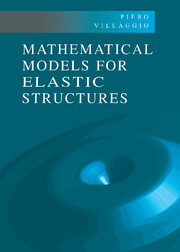Book contents
- Frontmatter
- Contents
- Preface
- Introduction
- Chapter I Basic Concepts
- Chapter II Rod Theories: Three-dimensional Approach
- Chapter III Rod Theories: Director Approach
- Chapter IV Theories of Cables
- Chapter V Theories of Membranes
- Chapter VI Theories of Plates
- Chapter VII Theories of Shells
- References
- Index of Authors Cited
- Index
Chapter IV - Theories of Cables
Published online by Cambridge University Press: 11 September 2009
- Frontmatter
- Contents
- Preface
- Introduction
- Chapter I Basic Concepts
- Chapter II Rod Theories: Three-dimensional Approach
- Chapter III Rod Theories: Director Approach
- Chapter IV Theories of Cables
- Chapter V Theories of Membranes
- Chapter VI Theories of Plates
- Chapter VII Theories of Shells
- References
- Index of Authors Cited
- Index
Summary
Equilibrium Equations
Strings are slender bodies like rods, but are characterized by the properties that they cannot withstand compression or bending and can adapt their shape to any form of loading. They are important because they have wide technical applications, such as those required for the construction of suspension bridges, wire meshes, musical instruments, and nets of textile material. Strings are the vehicle through which some of the methods of mathematical physics have found their simplest applications.
Strings were used by Stevin in 1586 to given an experimental demonstration of the law of the triangle of forces. It seems likely that, in 1615, Beeckman solved the problem of finding the shape of a cable modeled as a string under a load uniformly distributed in a plane, and found that the string hangs in a parabolic arc. The problem of finding the configuration of a chain hanging under its own weight was considered by Galilei (1638), in his Discorsi, who concluded, erroneously, that the chain assumes a parabolic form. Subsequently, Leibniz, Huygens and James Bernoulli, apparently independently, discovered the solution now known as the catenary, taking its name from the Latin for a suspended chain. In investigating the catenary, different approaches were employed: Huygens relied on geometrical considerations, while Leibniz and James Bernoulli relied on the calculus. However, at the same time, Hooke (1675) found that a moment-free arch supports its own weight with a curve which is an inverted catenary. Another long-debated problem was that of velaria, that is, the curve assumed by an inextensible weightless string subjected to a normal force of constant magnitude. This is the form of a cylindrical sail under the action of a uniform wind, the name having its origin in this example. Huygens incorrectly stated that the curve is a parabola, but James Bernoulli aptly proved that the velaria is a circle.
The vibration of taut strings was extensively studied by d'Alembert, Daniel Bernoulli and Lagrange in the early part of the eighteenth century. Daniel Bernoulli (1733) found a solution for the natural frequencies of a chain hanging from one end.
- Type
- Chapter
- Information
- Mathematical Models for Elastic Structures , pp. 303 - 365Publisher: Cambridge University PressPrint publication year: 1997



